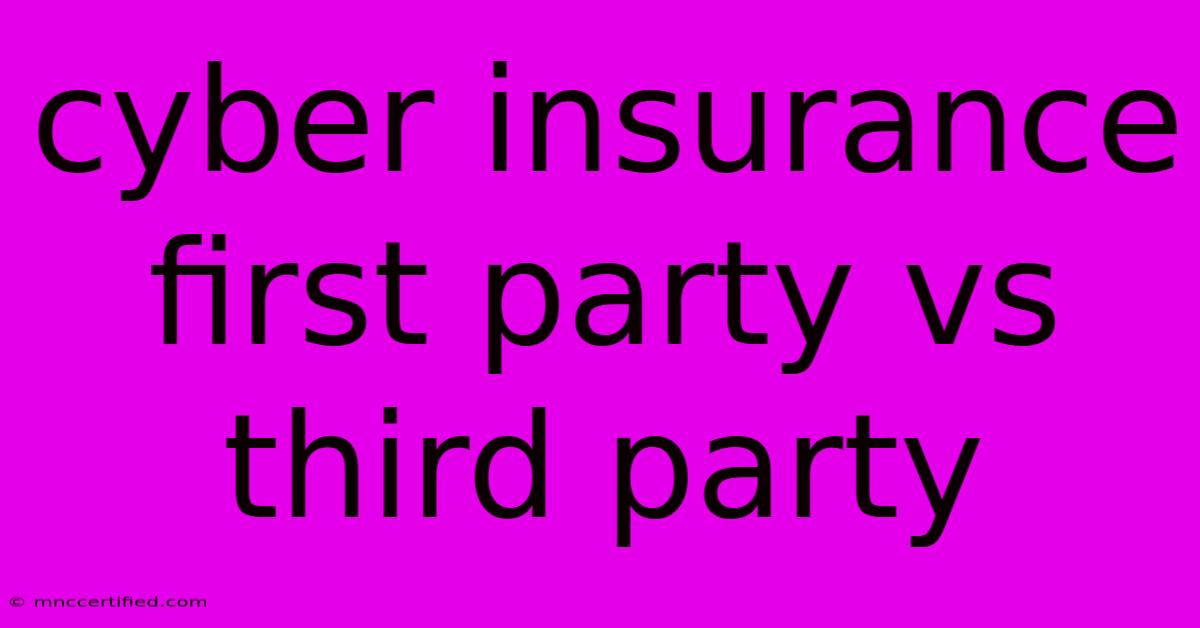Cyber Insurance First Party Vs Third Party

Table of Contents
Cyber Insurance: First-Party vs. Third-Party Coverage Explained
In today's digital world, businesses are increasingly vulnerable to cyberattacks. A robust cyber insurance policy is essential to mitigate financial losses and ensure operational continuity. However, understanding the different types of coverage offered can be challenging. This article breaks down the key differences between first-party and third-party coverage in cyber insurance, helping you determine the right level of protection for your organization.
First-Party Coverage: Protecting Your Own Business
First-party coverage in cyber insurance focuses on protecting your own organization from direct financial losses caused by cyber incidents. These losses can include:
- Data Breach Expenses: Costs associated with notifying affected individuals, credit monitoring services, legal fees, and regulatory fines.
- Business Interruption: Loss of income due to system downtime, website outages, or disruptions in operations.
- Data Recovery and Restoration: Expenses incurred in recovering lost or corrupted data, rebuilding systems, and restoring operations.
- Cyber Extortion: Costs associated with ransom payments or other demands from cybercriminals.
- Crisis Management: Expenses for public relations, legal counsel, and other crisis response efforts.
Key Examples of First-Party Coverage:
- Data Breach Response: Covers the costs of responding to a data breach, including forensic investigation, legal counsel, and notification of affected individuals.
- Business Interruption Insurance: Provides financial compensation for lost revenue and ongoing expenses during the period of business disruption caused by a cyberattack.
- Cyber Extortion Coverage: Covers the costs of ransom payments, but often comes with strict conditions and limitations.
Third-Party Coverage: Protecting Others from Your Actions
Third-party coverage in cyber insurance focuses on protecting your business from liability claims arising from cyber incidents that affect other parties. These claims can be brought by customers, clients, employees, or even regulatory bodies.
Key Examples of Third-Party Coverage:
- Privacy Liability: Covers legal costs and settlements related to claims of data breaches, privacy violations, and identity theft.
- Network Security Liability: Protects against claims arising from network security breaches that impact other parties, such as malware distribution or denial-of-service attacks.
- Cyber Crime Liability: Covers claims related to cybercrime activities like phishing, malware, and ransomware attacks that cause harm to third parties.
Why is Third-Party Coverage Important?
In today's connected world, a cyber incident affecting your business can easily impact others. For example, a ransomware attack could lead to the theft of sensitive customer data, resulting in liability claims for negligence or breach of privacy. Third-party coverage provides a crucial layer of protection against these risks, safeguarding your business from potentially devastating financial consequences.
Combining First-Party and Third-Party Coverage
Most comprehensive cyber insurance policies offer a combination of first-party and third-party coverage. This provides a holistic approach to mitigating cyber risks, protecting your organization from both direct losses and potential liability claims.
Key Factors to Consider When Choosing Cyber Insurance:
- Your Industry and Business Operations: The specific risks you face will vary depending on your industry and the nature of your business.
- Data Security Practices: Strong security measures can help mitigate risks, but coverage is still essential to handle unforeseen incidents.
- Budget and Risk Tolerance: Determine your budget for cyber insurance and your willingness to absorb potential losses.
- Insurance Provider: Choose a reputable provider with a proven track record in cyber insurance.
By understanding the differences between first-party and third-party cyber insurance coverage, you can make informed decisions about the level of protection needed to safeguard your business in the digital age. Consult with a qualified insurance broker to tailor a policy that addresses your specific needs and vulnerabilities.

Thank you for visiting our website wich cover about Cyber Insurance First Party Vs Third Party. We hope the information provided has been useful to you. Feel free to contact us if you have any questions or need further assistance. See you next time and dont miss to bookmark.
Featured Posts
-
Criminal Justice Reform Wins In California Prop 36
Nov 07, 2024
-
Insurance Companies That Cover Wood Stoves
Nov 07, 2024
-
Shetland Returns Episode 1 November 6 On Bbc One
Nov 07, 2024
-
Gary Barlow Sons Height Towering Over Take That
Nov 07, 2024
-
Wisconsin Constitution Now Bars Affirmative Action
Nov 07, 2024